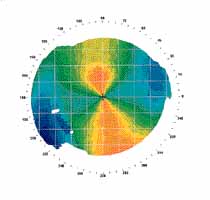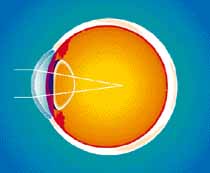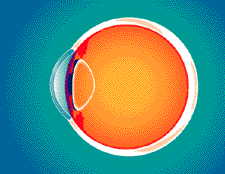Zap Day

| Staring Into a Laser Beam
Zap Day |
 |
| --Scott Rainey | |
 The Screening
The ScreeningNext, I was walked across the hall to the operating room where I was laid upon what looked to be a pretty normal dentists chair, and introduced to the real green dot. The doctor's assistant helped me get oriented, then the doctor himself came in, inserted the eyeball speculum (think Clockwork Orange) and set about settling me in for the actual zap. The eye speculum is a hideous thing to contemplate, however I barely felt it, which I must credit to the doctor's gentle skills and the excellent eye drops. In the Operating Room (OR) they show me how the laser process will look, sound and smell (the smell is much like burnt hair). Then when I gave the OK, the process began. The sights, sounds and smells were exactly as advertised. In total, the computer controlled excimer laser spent 27 seconds re-shaping my right cornea. Dr. Rich placed a "bandage" contact lens over my treated eye, and with a few parting words, I was on my way out the door. The bandage contact is a standard disposable contact lens with a very minor prescription on the order of +0.50. Its job is to shield the cornea from all of the bugs and bacteria in the world as the first level of healing takes place. I could see through it, and although the world was fuzzy, I could concentrate and bring the world into focus adequately to read street signs - something I could not do an hour earlier. The payoff on all this prep work comes when they precisely position your eye under the Excimer Laser machine. Your cornea is then reshaped by precise bursts from the laser as controled by the computer software. As you lie reclining on the equivalent of a plush dentists chair, your ophthalmologist is carefully watching your position in the medical equivalent of cross hairs. When you are prepped, settled, and in the sweet spot, he presses a foot switch to start the program. Then under precise computer controls a series of laser pulses evaporates corneal tissue and reshapes the surface of your cornea. The pattern with the Nidek laser system is three passes of 10 scan lines each. After the first pass of 10 scanning lines, the axis of scan is rotated 120 degrees and repeated, rotated 120 degrees and repeated again. This gives a reasonably comprehensive and overlapping pattern. Although the computer geek deep in my soul would ask for 100x100x100 line resolution, I am confident that such higher resolution has been tested and no real benefit found. Remember that you the patient are not inert matter. You are a living breathing, pulsing creature. You move a tiny bit all the time, even when restrained and drugged and trying hard to be still. The doctor does not do the entire eye at a single zap. but does a little at a time, pausing to check progress and to re-center the target (you), several times throughout the procedure. I was given 27 seconds on my Right eye, which took about 3 minutes to deliver. |
Home Page
|
 Focus problem in a nearsighted (myopic) eye |
 Animated GIF of PRK process (91k) |